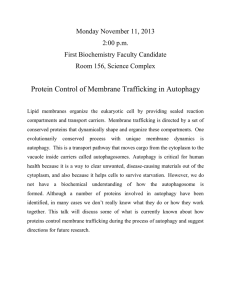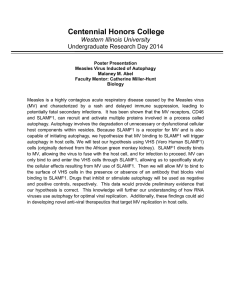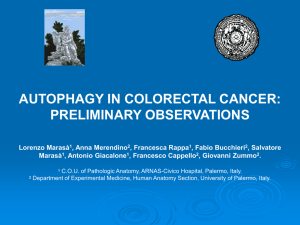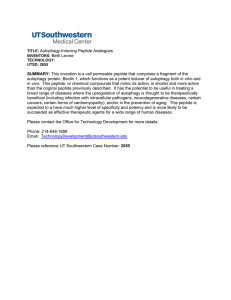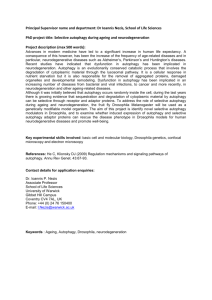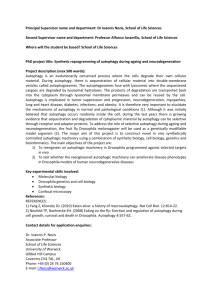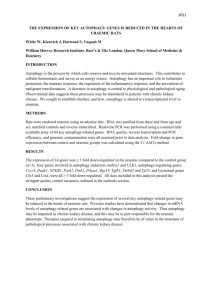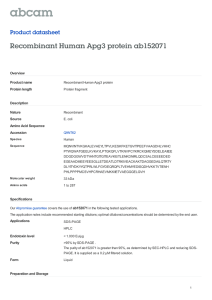distribute.
advertisement
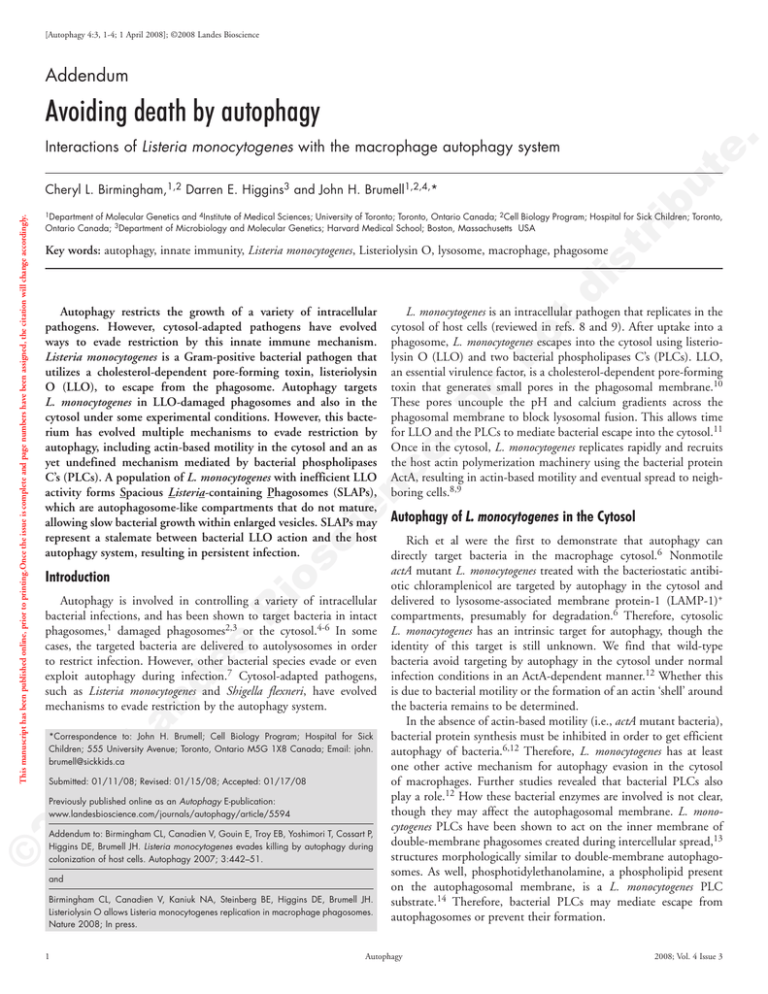
[Autophagy 4:3, -4; 1 April 2008]; ©2008 Landes Bioscience Addendum Avoiding death by autophagy te . Interactions of Listeria monocytogenes with the macrophage autophagy system ib u of Molecular Genetics and 4Institute of Medical Sciences; University of Toronto; Toronto, Ontario Canada; 2Cell Biology Program; Hospital for Sick Children; Toronto, Ontario Canada; 3Department of Microbiology and Molecular Genetics; Harvard Medical School; Boston, Massachusetts USA st r 1Department .D o no t L. monocytogenes is an intracellular pathogen that replicates in the cytosol of host cells (reviewed in refs. 8 and 9). After uptake into a phagosome, L. monocytogenes escapes into the cytosol using listeriolysin O (LLO) and two bacterial phospholipases C’s (PLCs). LLO, an essential virulence factor, is a cholesterol‑dependent pore-forming toxin that generates small pores in the phagosomal membrane.10 These pores uncouple the pH and calcium gradients across the phagosomal membrane to block lysosomal fusion. This allows time for LLO and the PLCs to mediate bacterial escape into the cytosol.11 Once in the cytosol, L. monocytogenes replicates rapidly and recruits the host actin polymerization machinery using the bacterial protein ActA, resulting in actin‑based motility and eventual spread to neighboring cells.8,9 io s ci en ce Autophagy restricts the growth of a variety of intracellular pathogens. However, cytosol-adapted pathogens have evolved ways to evade restriction by this innate immune mechanism. Listeria monocytogenes is a Gram-positive bacterial pathogen that utilizes a cholesterol-dependent pore-forming toxin, listeriolysin O (LLO), to escape from the phagosome. Autophagy targets L. monocytogenes in LLO-damaged phagosomes and also in the cytosol under some experimental conditions. However, this bacterium has evolved multiple mechanisms to evade restriction by autophagy, including actin-based motility in the cytosol and an as yet undefined mechanism mediated by bacterial phospholipases C’s (PLCs). A population of L. monocytogenes with inefficient LLO activity forms Spacious Listeria-containing Phagosomes (SLAPs), which are autophagosome-like compartments that do not mature, allowing slow bacterial growth within enlarged vesicles. SLAPs may represent a stalemate between bacterial LLO action and the host autophagy system, resulting in persistent infection. di Key words: autophagy, innate immunity, Listeria monocytogenes, Listeriolysin O, lysosome, macrophage, phagosome Introduction La nd es B Autophagy is involved in controlling a variety of intracellular bacterial infections, and has been shown to target bacteria in intact phagosomes,1 damaged phagosomes2,3 or the cytosol.4-6 In some cases, the targeted bacteria are delivered to autolysosomes in order to restrict infection. However, other bacterial species evade or even exploit autophagy during infection.7 Cytosol‑adapted pathogens, such as Listeria monocytogenes and Shigella flexneri, have evolved mechanisms to evade restriction by the autophagy system. 08 *Correspondence to: John H. Brumell; Cell Biology Program; Hospital for Sick Children; 555 University Avenue; Toronto, Ontario M5G 1X8 Canada; Email: john. brumell@sickkids.ca Submitted: 01/11/08; Revised: 01/15/08; Accepted: 01/17/08 Previously published online as an Autophagy E-publication: www.landesbioscience.com/journals/autophagy/article/5594 © 20 This manuscript has been published online, prior to printing.Once the issue is complete and page numbers have been assigned, the citation will change accordingly. Cheryl L. Birmingham,1,2 Darren E. Higgins3 and John H. Brumell1,2,4,* Addendum to: Birmingham CL, Canadien V, Gouin E, Troy EB, Yoshimori T, Cossart P, Higgins DE, Brumell JH. Listeria monocytogenes evades killing by autophagy during colonization of host cells. Autophagy 2007; 3:442–51. and Birmingham CL, Canadien V, Kaniuk NA, Steinberg BE, Higgins DE, Brumell JH. Listeriolysin O allows Listeria monocytogenes replication in macrophage phagosomes. Nature 2008; In press. Autophagy of L. monocytogenes in the Cytosol Rich et al were the first to demonstrate that autophagy can directly target bacteria in the macrophage cytosol.6 Nonmotile actA mutant L. monocytogenes treated with the bacteriostatic antibiotic chloramplenicol are targeted by autophagy in the cytosol and delivered to lysosome‑associated membrane protein‑1 (LAMP‑1)+ compartments, presumably for degradation.6 Therefore, cytosolic L. monocytogenes has an intrinsic target for autophagy, though the identity of this target is still unknown. We find that wild‑type bacteria avoid targeting by autophagy in the cytosol under normal infection conditions in an ActA‑dependent manner.12 Whether this is due to bacterial motility or the formation of an actin ‘shell’ around the bacteria remains to be determined. In the absence of actin‑based motility (i.e., actA mutant bacteria), bacterial protein synthesis must be inhibited in order to get efficient autophagy of bacteria.6,12 Therefore, L. monocytogenes has at least one other active mechanism for autophagy evasion in the cytosol of macrophages. Further studies revealed that bacterial PLCs also play a role.12 How these bacterial enzymes are involved is not clear, though they may affect the autophagosomal membrane. L. mono‑ cytogenes PLCs have been shown to act on the inner membrane of double‑membrane phagosomes created during intercellular spread,13 structures morphologically similar to double‑membrane autophagosomes. As well, phosphotidylethanolamine, a phospholipid present on the autophagosomal membrane, is a L. monocytogenes PLC substrate.14 Therefore, bacterial PLCs may mediate escape from autophagosomes or prevent their formation. Autophagy 2008; Vol. 4 Issue 3 Listeria evades killing by autophagy ib u te . S. flexneri is another cytosol‑adapted pathogen that evades autophagy in the cytosol. Ogawa et al showed that the essential autophagy protein, Atg5, binds the bacterial cell surface protein IcsA.5 However, this only occurs in the absence of another bacterial protein, IcsB, which binds to IcsA at the same site as Atg5. In this way, IcsB acts as a ‘molecular shield’ to mask IcsA from binding to Atg5, thereby preventing autophagy of bacteria.5 Notably, these S. flexneri studies were performed in nonprofessional phagocytic cells. di no t o .D Figure 1. Spacious Listeria‑containing phagosomes (SLAPs) in vitro and in vivo. TEM images of A) RAW 264.7 macrophages infected for 4 h or 8 h, and B) liver granulomas from SCID mice infected for 21 days with L. monocytogenes. Shown are examples of spacious vesicles containing multiple bacteria (SLAPs). Arrows indicate septa of dividing bacteria. Size bars = 0.5 mm. Figure adapted (from Birmingham et al., ref. 16). io s ci en ce To reach the cytosol, L. monocytogenes escapes from the phagosome using the pore-forming toxin, LLO. Surprisingly, L. monocytogenes is also targeted by autophagy during escape in an LLO‑dependent manner (~37% of total intracellular L. monocytogenes are LC3+ at 1 h post infection).12 The autophagy target at this time is unknown, though it may be the damaged vacuole itself, as has been previously suggested during infection with Salmonella typhimurium2 and Toxoplasma gondii.3 As L. monocytogenes infection progresses, the fraction of bacteria colocalizing with the autophagy marker LC3 drops rapidly (~10% by 4 h post infection).12 In fibroblasts, bacteria are also targeted by autophagy at 1 h post infection. However, overall bacterial replication is not significantly different in autophagy‑deficient versus autophagy‑competent fibroblasts.12 Therefore, even though the bacteria are targeted by autophagy, they do not appear to be killed in the autolysosome in this cell‑type. S. flexneri can also be targeted by the macrophage autophagy system within 30 min post infection (p.i.) in a manner independent of IcsA.15 Autophagy in this case is dependent on the bacterial type III‑secretion system and modulated by the Nod‑like receptor protein Ipaf.15 Whether S. flexneri is being targeted by autophagy during escape from the phagosome in a manner similar to L. monocytogenes remains to be determined. st r Autophagy of L. monocytogenes During Phagosomal Escape Spacious Listeria‑Containing Phagosomes (SLAPs) © 20 08 La nd es B The population of L. monocytogenes targeted by autophagy during phagosomal escape has several possible fates, including degradation in the autolysosome (although this is not sufficient to have an impact upon overall replication12), escape from the autophagosome12 or formation of Spacious Listeria‑containing Phagosomes (SLAPs).16 SLAPs are spacious vesicular compartments formed by a small population of L. monocytogenes (Fig. 1) that do not appear to have escaped from the phagosome.16 SLAPs require autophagy to form, and label with both endocytic and autophagic markers. L. monocytogenes replicate in these compartments, though at a much slower rate compared to cytosolic bacteria. Indeed, maturation of these autophagosome‑like compartments is blocked by LLO, which uncouples the pH gradient across the SLAP membrane16 in a manner similar to LLO‑mediated phagosomal escape.11 Using hly mutant bacteria that express inducible LLO,13 we found that low levels of LLO expression (~33% of wild‑type LLO activity13) allow bacterial growth in vesicles. This growth is slower than that of wild‑type bacteria in the cytosol, and reaches maximal intracellular bacterial levels after a much longer period of time (3 days versus 12 h, respectively).16 Therefore, LLO allows replication of L. monocyto‑ genes in SLAPs when its activity is not sufficient to drive escape into the cytosol, but is sufficient to block lysosomal fusion. What affects the LLO expression of bacteria in SLAPs is unknown. However, www.landesbioscience.com LLO activity is inefficient in LAMP‑1­+17 and alkaline18 compart­ ments, both characteristics of SLAPs. As well, LLO function can be impaired by innate immune defenses, such as reactive oxygen and nitrogen intermediates19 and cathepsin D.20 Phagosome maturation is heterogeneous, and therefore bacteria in SLAPs may be targeted by host innate factors differently than those that successfully escape from the phagosome. SLAPs may occur under specific conditions in vivo. SCID mice lack adaptive immunity, which normally clears L. monocytogenes infection, and can develop a persistent infection in which L. monocy‑ togenes is present in the liver for up to 21 days p.i.21 In these animals, bacteria localize to spacious vesicles in macrophages, structures that are morphologically indistinguishable from SLAPs observed in tissue culture cells (Fig. 1).16,21 Therefore, it is possible that SLAP formation is a mechanism by which persistent L. monocytogenes infection is established. Summary and Future Considerations In Figure 2, we propose a model summarizing the multiple populations that arise during L. monocytogenes infection of macrophages. L. monocytogenes can be targeted by autophagy, but has evolved multiple mechanisms to evade restriction by this system, including ActA and PLC‑dependent mechanisms, and SLAP formation. SLAPs appear to represent a stalemate between macrophage innate immunity (including autophagy) and bacterial virulence (including LLO). Therefore, LLO plays several important roles during intracellular infection. LLO blocks fusion of the primary phagosome with lysosomes,11 allows bacterial escape into the cytosol to cause Autophagy o no t di st r ib u te . Listeria evades killing by autophagy io s ci en ce .D Figure 2. Model of bacterial populations during L. monocytogenes infection of macrophages. Bacteria are taken up by macrophages into a phagosome, and a proportion of these bacteria are degraded in a phagolysosome30 (Population 1). To avoid this fate, L. monocytogenes expresses LLO and PLCs to disrupt the phagosomal membrane. Pores created by LLO in the phagosomal membrane block lysosomal fusion and maturation of this compartment.11 The host autophagy system may target bacteria during phagosomal escape. Bacteria targeted by autophagy may then be degraded in autolysosomes or evade growth restriction by the autophagy system, possibly through the use of bacterial PLCs. A small population of L. monocytogenes has low or inefficient LLO activity. This low LLO activity is sufficient to block maturation of the vacuolar compartment, but is not sufficient to mediate escape. Continual damage to the compartment membrane causes more recruitment of autophagy, resulting in the formation of large spacious vesicles or SLAPs (Population 2).16 The formation of these structures drastically slows bacterial replication (doubling time (D.T.) of approximately 8 h16), but does not clear infection. Therefore, SLAP formation may be the result of a stalemate between LLO‑mediated bacterial virulence and the macrophage autophagy system, resulting in persistent infection.16 The proportion of intracellular L. monocytogenes believed to cause acute infection escapes from the phagosome using LLO and PLCs, and replicates rapidly in the cytosol (doubling time of approximately 40 min9,30). ActA recruits the host actin polymerization machinery, resulting in actin‑based motility, autophagy evasion and spread to neighboring cells (Population 3). © 20 08 La nd es B acute infection,8 and damages the phagosomal membrane to trigger autophagy, allowing L. monocytogenes growth in SLAPs and possibly persistent infection.16 As well, LLO has been shown to be involved in signal transduction activation (i.e., NFkB, PKC and MAPK pathways)10,22 and epigenetic changes in the host cell,23 indicating that there is a remarkable array of virulence functions associated with LLO. Pathogen growth in SLAP‑like structures may occur during other bacterial infections. Spacious endosome‑ or autophagosome‑like compartments containing multiple bacteria have been observed during infection with Francisella tularensis,24 Staphylococcus aureus,25 Porphyromonas gingivalis,26 Coxiella burnetti27 and Helicobacter pylori.28 Mysorekar and Hultgren showed that uropathogenic Escherichia coli can reside in large endocytic vesicles in bladder epithelial cells of mice.29 These quiescent intracellular bacterial reservoirs can cause recurring bladder infection.29 It is tempting to speculate that other pathogens known to cause persistent infections may also grow in vesicles formed by the host autophagy system. References 1. Gutierrez MG, Master SS, Singh SB, Taylor GA, Colombo MI, Deretic V. Autophagy is a defense mechanism inhibiting BCG and Mycobacterium tuberculosis survival in infected macrophages. Cell 2004; 119:753‑66. 2. Birmingham CL, Smith AC, Bakowski MA, Yoshimori T, Brumell JH. Autophagy controls Salmonella infection in response to damage to the Salmonella‑containing vacuole. J Biol Chem 2006; 281:11374‑83. 3. Martens S, Parvanova I, Zerrahn J, Griffiths G, Schell G, Reichmann G, Howard JC. Disruption of Toxoplasma gondii parasitophorous vacuoles by the mouse p47‑resistance GTPases. PLoS Pathog 2005; 1:e24. 4. Nakagawa I, Amano A, Mizushima N, Yamamoto A, Yamaguchi H, Kamimoto T, Nara A, Funao J, Nakata M, Tsuda K, Hamada S, Yoshimori T. Autophagy defends cells against invading group A Streptococcus. Science 2004; 306:1037‑40. 5. Ogawa M, Yoshimori T, Suzuki T, Sagara H, Mizushima N, Sasakawa C. Escape of intracellular Shigella from autophagy. Science 2005; 307:727‑31. 6. Rich KA, Burkett C, Webster P. Cytoplasmic bacteria can be targets for autophagy. Cell Microbiol 2003; 5:455‑68. 7. Schmid D, Munz C. Innate and adaptive immunity through autophagy. Immunity 2007; 27:11‑21. 8. Hamon M, Bierne H, Cossart P. Listeria monocytogenes: A multifaceted model. Nat Rev Microbiol 2006; 4:423‑34. 9. Portnoy DA, Auerbuch V, Glomski IJ. The cell biology of Listeria monocytogenes infection: The intersection of bacterial pathogenesis and cell‑mediated immunity. J Cell Biol 2002; 158:409‑14. 10. Kayal S, Charbit A. Listeriolysin O: A key protein of Listeria monocytogenes with multiple functions. FEMS Microbiol Rev 2006; 30:514‑29. 11. Shaughnessy LM, Hoppe AD, Christensen KA, Swanson JA. Membrane perforations inhibit lysosome fusion by altering pH and calcium in Listeria monocytogenes vacuoles. Cell Microbiol 2006; 8:781‑92. 12. Birmingham CL, Canadien V, Gouin E, Troy EB, Yoshimori T, Cossart P, Higgins DE, Brumell JH. Listeria monocytogenes evades killing by autophagy during colonization of host cells. Autophagy 2007; 3:442‑51. 13. Alberti‑Segui C, Goeden KR, Higgins DE. Differential function of Listeria monocytogenes listeriolysin O and phospholipases C in vacuolar dissolution following cell‑to‑cell spread. Cell Microbiol 2007; 9:179‑95. 14. Geoffroy C, Raveneau J, Beretti JL, Lecroisey A, Vazquez‑Boland JA, Alouf JE, Berche P. Purification and characterization of an extracellular 29‑kilodalton phospholipase C from Listeria monocytogenes. Infect Immun 1991; 59:2382‑8. 15. Suzuki T, Nunez G. A role for Nod‑like receptors in autophagy induced by Shigella infection. Autophagy 2007; 4: 73-5. Autophagy 2008; Vol. 4 Issue 3 ib u st r di no t o .D © 20 08 La nd es B io s ci en ce 16. Birmingham CL, Canadien V, Kaniuk NA, Steinberg BE, Higgins DE, Brumell JH. Listeriolysin O allows Listeria monocytogenes replication in macrophage vacuoles. Nature 2008; In press. 17. Henry R, Shaughnessy L, Loessner MJ, Alberti‑Segui C, Higgins DE, Swanson JA. Cytolysin‑dependent delay of vacuole maturation in macrophages infected with Listeria monocytogenes. Cell Microbiol 2006; 8:107‑19. 18. Beauregard KE, Lee KD, Collier RJ, Swanson JA. pH‑dependent perforation of macrophage phagosomes by listeriolysin O from Listeria monocytogenes. J Exp Med 1997; 186:1159‑63. 19. Myers JT, Tsang AW, Swanson JA. Localized reactive oxygen and nitrogen intermediates inhibit escape of Listeria monocytogenes from vacuoles in activated macrophages. J Immunol 2003; 171:5447‑53. 20. del Cerro‑Vadillo E, Madrazo‑Toca F, Carrasco-Marin E, Fernandez‑Prieto L, Beck C, Leyva‑Cobian F, Saftig P, Alvarez‑Dominguez C. Cutting edge: A novel nonoxidative phagosomal mechanism exerted by cathepsin‑D controls Listeria monocytogenes intracellular growth. J Immunol 2006; 176:1321‑5. 21. Bhardwaj V, Kanagawa O, Swanson PE, Unanue ER. Chronic Listeria infection in SCID mice: Requirements for the carrier state and the dual role of T cells in transferring protection or suppression. J Immunol 1998; 160:376‑84. 22. Tang P, Rosenshine I, Cossart P, Finlay BB. Listeriolysin O activates mitogen‑activated protein kinase in eucaryotic cells. Infect Immun 1996; 64:2359‑61. 23. Hamon MA, Batsche E, Regnault B, Tham TN, Seveau S, Muchardt C, Cossart P. Histone modifications induced by a family of bacterial toxins. Proc Natl Acad Sci USA 2007; 104:13467‑72. 24. Checroun C, Wehrly TD, Fischer ER, Hayes SF, Celli J. Autophagy‑mediated reentry of Francisella tularensis into the endocytic compartment after cytoplasmic replication. Proc Natl Acad Sci USA 2006; 103:14578‑83. 25. Schnaith A, Kashkar H, Leggio SA, Addicks K, Kronke M, Krut O. Staphylococcus aureus subvert autophagy for induction of caspase‑independent host cell death. J Biol Chem 2007; 282:2695‑706. 26. Dorn BR, Dunn Jr WA, Progulske‑Fox A. Porphyromonas gingivalis traffics to autophagosomes in human coronary artery endothelial cells. Infect Immun 2001; 69:5698‑708. 27. Gutierrez MG, Vazquez CL, Munafo DB, Zoppino FC, Beron W, Rabinovitch M, Colombo MI. Autophagy induction favours the generation and maturation of the Coxiella‑replicative vacuoles. Cell Microbiol 2005; 7:981‑93. 28. Necchi V, Candusso ME, Tava F, Luinetti O, Ventura U, Fiocca R, Ricci V, Solcia E. Intracellular, intercellular, and stromal invasion of gastric mucosa, preneoplastic lesions, and cancer by Helicobacter pylori. Gastroenterology 2007; 132:1009‑23. 29. Mysorekar IU, Hultgren SJ. Mechanisms of uropathogenic Escherichia coli persistence and eradication from the urinary tract. Proc Natl Acad Sci USA 2006; 103:14170‑5. 30. de Chastellier C, Berche P. Fate of Listeria monocytogenes in murine macrophages: Evidence for simultaneous killing and survival of intracellular bacteria. Infect Immun 1994; 62:543‑53. te . Listeria evades killing by autophagy www.landesbioscience.com Autophagy
